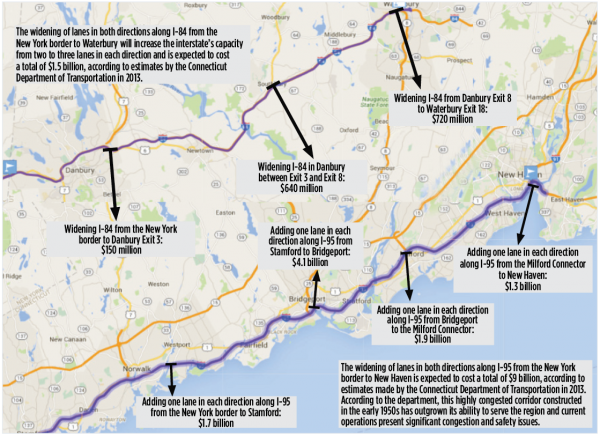Connecticut sees billion-dollar benefits in interstate work
Preliminary estimates for the economic impact generated by the widening of southern Connecticut”™s major transit arteries, Interstate 84 and Interstate 95, are in and the outlook is promising with economic benefits of nearly $40 billion predicted ”“ more than three times the $12.2 billion the combined projects are predicted to cost.
The analysis is part of Gov. Dannel Malloy”™s and the Department of Transportation”™s “Let”™s Go CT” campaign announced earlier this year. The project is a $100-billion, 30-year vision for an overhaul of the state”™s seaports, highways, bus and rail systems as well as pedestrian and bicyclist pathways.
The projects would boost most sectors of the state”™s economy, particularly in the manufacturing, retail and tourism industries in the form of new business, wages and an increase in the gross state product, Malloy said announcing the findings.
“It”™s not just about quality of life ”” our transportation system is directly tied to our state”™s economic future and our ability to grow jobs,” he said. “By acting now, we will see dramatic benefits in the long term.”
According to the state DOT, daily traffic varies widely but, on average, the I-95 corridor accommodates more than 135,000 vehicles daily, including more than 18,000 trucks on some portions. Adding a lane in each direction on I-95 across southern Connecticut could produce $15.5 billion in new business sales, add $9 billion to the gross state product and add $6.3 billion in new wage income to workers. The widening itself will cost $10.7 billion and support between 11,000 and 19,000 construction jobs over a 10-year ramp-up construction period.
The transportation department estimates every year each Connecticut driver spends 40 hours sitting in traffic due to the state”™s congested roads ”” costing $1.6 billion in lost time and fuel.
In a survey by the Connecticut Business and Industry Association, 42 percent of businesses surveyed believe the state”™s road congestion restricts or limits the territory of their market. In the same survey, 15 percent of businesses said they have considered relocating because of regional transportation concerns.
Chris Bruhl, president and CEO of the Business Council of Fairfield County, has not heard from members that the current condition of the transit infrastructure is deterring new businesses or propelling them from the state, though it is a concern for the near future.
“It is a steady theme that we hear ”” that improvement in employee commutes are essential in the future,” he said. “It is on everybody”™s mind, in Fairfield the commute is like the weather in an agricultural community.”
On I-84, more than 80,000 drivers are estimated to use the corridor daily. Widening the highway could produce $4.4 billion in new business sales, add $2.6 billion to the gross state product and add $1.8 billion in new wage income for workers, the economic analysis concluded. The total cost of the project is $1.5 billion and will support 4,000 construction jobs.
Both improvements are years away, said Thomas Maziarz, bureau chief for the DOT”™s Bureau of Policy and Planning, but there are many smaller projects aimed at easing congestion as well as bolstering rail and bridge safety that are already being addressed as part of Let”™s Go CT”™s five-year ramp-up plan ”” currently supported by $6.6 billion in designated funds.
Now in the first year of a 5 year initial plan, Mariarz said those smaller-scale projects can be addressed before the future design and construction phases for the interstates take shape.
Notably among these are the easing of congestion between exits 3 and 8 on I-84 and between Stamford and Bridgeport on I-95 ”” what Mariarz referred to as the “most congested” section of the state”™s transit corridors with traffic jams  that can reach 20 miles in length regularly, even daily.
The design work for the New York to Stamford portion of I-95 could be even further off, he said.
“We are probably several years away from being able to even think about the design on the Stamford to New York section,” he said.
The next step in the phase is a continued analysis of the scope of the plan, which will be put before Malloy and the Transportation Finance Panel in December for review and analysis of future funding strategies.
